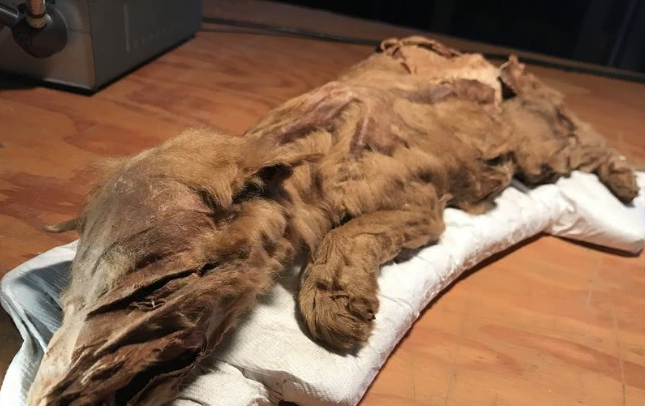(单词翻译:单击)
The rare remains of an ice-age wolf pup and a caribou will offer insights about life in Canada's far north more than 50,000 years ago, scientists say.
科学家表示,冰河时代一只狼崽和一只驯鹿的罕见遗骸,将有助于人们了解加拿大远北地区5万多年前的生活。
The creatures were discovered with intact hair, skin, and muscle tissue.
被发现的这些生物的皮毛、皮肤和肌肉组织都完好无损。
They were found in 2016 by miners near Dawson City in Yukon, and handed over to palaeontologists for research and analysis.
它们是于2016年在育空地区道森市附近被矿工发现的,并被交给古生物学家进行研究和分析。
"They are among the oldest mummified mammal soft tissue in the world," palaeontologist Grant Zazula said.
古生物学家格兰特·扎祖拉表示:“这些遗骸是世界上最古老的哺乳动物干尸软组织之一。”

The wolf pup is estimated to have been about eight weeks old when it died.
据估计,该狼崽死时大约是八周大。
"It's beautiful, the fur, it's got the cute little paws and tail and the curled upper lip showing its teeth. It's spectacular," Mr Zazula told the Canadian Press news agency last Thursday.
扎祖拉上周四向加拿大新闻社透露:“它的皮毛很漂亮,有可爱的小爪子和尾巴以及卷曲的上唇露出牙齿。太美了。”
The caribou remains include the torso, head, and front limbs.
而那只驯鹿的遗体则包括躯干、头部和前肢。
Both specimens are currently on display in Dawson City and will eventually be sent to the Canadian Conservation Institute near Ottawa. They are expected to help scientists understand how they lived in the environment they inhabited.
这两个标本目前都在道森市展出,最终将被送往渥太华附近的加拿大保护研究所。它们将有助于科学家了解这两种动物是如何在栖息地生活的。


